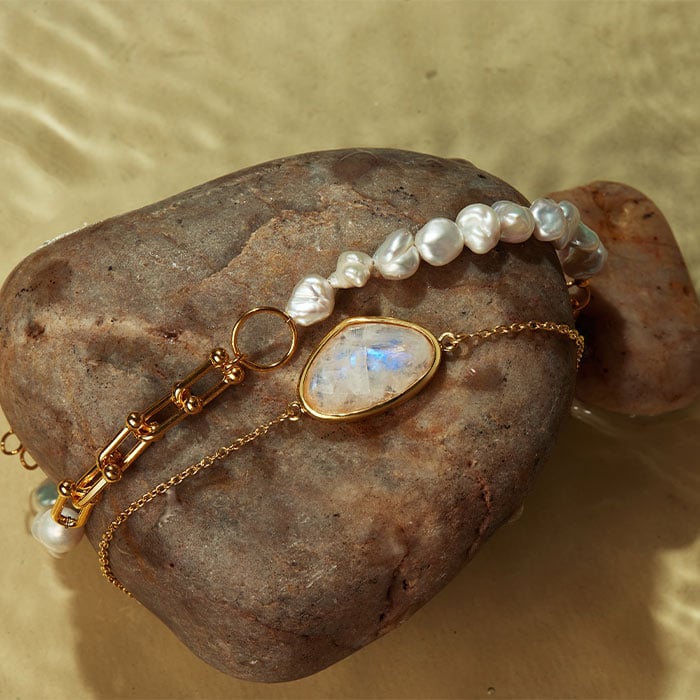Introduction to Silver Jewelry and Pools
Silver jewelry holds a special place in many peoples’ hearts. Its bright luster and timeless elegance make it a popular choice for both daily wear and special occasions. However, when it comes to swimming or lounging by the pool, you might want to think twice before taking a dip with your silver pieces on.
Pools typically contain chlorine, a chemical used to keep the water clean and safe for swimmers. While chlorine is effective at killing harmful bacteria, it can have adverse effects on silver jewelry. Over time, the interaction between silver and chlorine can lead to tarnishing, discoloration, and even structural damage to your jewelry.
Understanding how pool water impacts silver is crucial. This knowledge will guide you in making informed decisions about wearing silver jewelry in pool settings. In the upcoming sections, we will delve deeper into the chemistry of silver and chlorine, and provide practical insights to keep your cherished items safe and sparkling.
Understanding the Effects of Chlorine on Silver
When silver jewelry meets pool water, a hidden reaction begins. Chlorine, the very chemical that keeps pool water safe, can attack silver. This is due to a chemical reaction called oxidation. Oxidation happens when silver contacts substances like chlorine. This can cause the silver to tarnish. Tarnishing shows as a dull, dark coating on the jewelry’s surface. It steals the shine that makes silver so attractive.
But tarnish is not the only worry. The presence of chlorine can also lead to corrosion. Corrosion weakens the silver. Over time, this could mean bending or breaks in your favorite pieces. It can also cause pitting on the surface of the metal. This makes your jewelry look worn and old before its time.
The rate at which these effects occur can vary. Factors include the silver’s purity and the chlorine’s concentration. The more pure the silver, the more soft and reactive it is. And, the higher the chlorine content, the quicker the damage may happen. This means that indulging in a pool day while wearing silver jewelry can have lasting consequences. It’s important to weigh these risks before deciding whether to keep your silver on.
Why You Should Think Twice Before Wearing Silver in Pool
Given the earlier discussion, there are good reasons to reconsider wearing silver jewelry in pool areas. Here’s a brief rundown of key facts you should keep in mind:
- Chlorine Causes Tarnishing: Chlorine reacts with silver, leading to tarnishing. This dulls the jewelry’s shine, diminishing its beauty.
- Risk Of Corrosion Is High: Ongoing exposure to chlorine can cause silver to corrode. This weakens the jewelry, which may result in breaking or bending.
- Pure Silver Is More Vulnerable: The higher the purity of your silver jewelry, the more susceptible it is to pool chemicals. Pure silver tends to be softer and more reactive.
- Quick Damage With High Chlorine Levels: Pools with more chlorine can hasten the adverse effects on your silver accessories.
All these points indicate that the chlorine in pool water poses a real threat to the integrity and appearance of silver jewelry. It’s best to err on the side of caution and leave your silver items safely out of the pool to avoid potential damage. By doing so, you extend the lifespan of your jewelry and ensure it remains a sparkling treasure for years to come.
Tips for Protecting Silver Jewelry from Pool Water Damage
Understanding the risks associated with wearing silver jewelry in pool water brings us to the necessity of knowing protective measures. Here are several tips to help safeguard your precious silver accessories from the damaging effects of chlorine:
- Remove Before Dipping: The simplest and most effective method to protect your jewelry is to remove it before entering the pool.
- Use a Protective Coating: Apply a thin layer of clear nail polish or a jewelry protectant to create a barrier against the chemicals.
- Rinse After Exposure: If your silver jewelry does come in contact with pool water, rinse it immediately with fresh water to remove any lingering chlorine.
- Store Wisely: Keep your silver in a cool, dry place when not in use, especially when you’re near a pool. Moisture can aggravate the chemical reactions.
- Regular Polishing: Regularly polish your silver with a cloth made for silver care to maintain its luster and create slight resistance to tarnishing.
- Avoid High Chlorine Pools: If you must wear your jewelry, choose pools with lower chlorine levels. However, it’s generally best to avoid the risk.
Remember, prevention is always better than cure. By following these tips not only do you preserve the beauty of your silver jewelry, but you also extend its lifespan, ensuring that it remains a cherished possession for many years.
The Do’s of Wearing Silver Jewelry in Pools
Even with known risks, you might need to wear silver in pools at times. Here are do’s to minimize harm:
- Choose Low Chlorine Pools: Opt for pools with low chlorine. Less chlorine means less risk to your jewelry.
- Wear Less Often: Limit how much you wear silver in the pool. The less contact, the better.
- Inspect Jewelry Regularly: Check for damage often. Early detection can prevent worse issues.
- Clean Promptly: After a swim, clean your silver right away. This can stop further damage.
- Dry Thoroughly: Ensure jewelry is dry before storing. This keeps tarnish at bay.
If you must wear your silver jewelry, be smart about it. Following these steps helps keep your items safe.
The Don’ts of Wearing Silver Jewelry in Pools
While some proactive steps can help minimize damage, there are certain actions you should avoid to protect your silver jewelry in pool settings:
- Don’t Ignore Chlorine Levels: Always be aware of the chlorine content in the pool; higher levels can speed up the tarnishing and corrosion process.
- Don’t Wear Delicate Pieces: Leave behind intricate or fragile silver items. These are more likely to suffer damage in the harsh chemical environment.
- Don’t Forget to Take Off Jewelry: It’s easy to jump into the water on impulse, but forgetting to remove silver can lead to irreversible damage.
- Don’t Store When Wet: Never put wet silver jewelry into storage. This can cause tarnishing and corrosion to happen even faster.
- Don’t Delay Cleaning After Exposure: If your silver does come in contact with pool water, clean it immediately. Waiting can make the damage worse.
Abstaining from these practices when considering wearing silver jewelry in the pool is critical. It ensures your pieces stay beautiful and strong for the long haul.
Cleaning and Maintenance Tips for Silver Jewelry Post-Pool Exposure
After exposing silver jewelry to pool water, proper cleaning and maintenance are key. Follow these steps:
- Immediate Rinsing: Rinse your silver immediately after pool exposure. Use fresh, clean water.
- Gentle Cleaning: Mix a small amount of mild soap with warm water. Gently clean the jewelry.
- Soft Cloth Use: Dry the silver completely with a soft, non-abrasive cloth. Avoid rough materials that may scratch the surface.
- Tarnish Removal: If tarnish appears, use a specialized silver polish or baking soda paste. Apply it following product instructions. Rinse well.
- Professional Care: For severe tarnish or damage, consider professional jewelry cleaning services.
- Regular Inspections: Check your jewelry for damage regularly. Early detection makes repair easier.
- Proper Storage: Store silver in anti-tarnish bags or cloths. Keep them away from direct sunlight and moisture.
Remember to handle your silver gently through all steps. A little care goes a long way in keeping your jewelry at its best.
Alternatives to Wearing Silver Jewelry While Swimming
Given the risks associated with wearing silver jewelry in pool water, seeking alternatives is a wise choice. By opting for non-silver jewelry while swimming, you can maintain your style without damaging precious items. Here are some recommendations:
- Opt for Stainless Steel: Stainless steel does not tarnish or corrode in chlorine. It’s a durable option.
- Wear Silicone Wristbands: Soft, waterproof, and trendy, silicone bands are perfect for the pool.
- Try Plastic Jewelry: Plastic jewelry can mimic the look of silver and is pool-safe.
- Go for Nylon or Fabric Accessories: These materials hold up well in water and add a fun twist to your outfit.
- Choose Rubber Watches: If you like to wear a watch while swimming, rubber watches are practical and stylish.
- Keep a Separate Set for Swimming: Have dedicated pool-appropriate jewelry to ensure your silver stays safe.
By following these alternatives, you keep your silver jewelry safe. At the same time, you remain stylish in and around the pool. Switching out silver for more resistant materials when in water can save you the hassle of rigorous maintenance routines that come with damage from chlorine exposure.
Tags: jewelry's shine, resistant materials, silver pieces, wearing silver jewelry in pool


